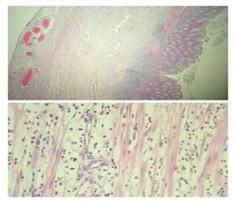Histopathological correlation of resected appendicectomy specimens - a five year study in a tertiary care centre in Kerala
Abstract
Background: Acute Appendicitis is one of the commoncause of acute abdomen leading to appendectomy which is one of the most frequently performed operations all over the world. Being a common surgery, appendicectomy specimens contribute a major part of routine specimens in any pathology laboratory. a large number of medical and surgical diseases can closely mimic appendicitis leading to negative appendicectomy.
Objectives: To find out the age, sex related incidence anddifferent histopathological lesions seen in resected appendicectomy specimens in a tertiary care centre in south India. We also tried to find out negative appendicectomy rate.
Materials and Method: This is a retrospective study conducted in the department of pathology, Sree Narayana Institute of Medical Sciences, Kerala. We analyzed the histopathology reports of thosepatients who had undergone appendicectomy in our hospitalduring last five year period (January 2014- December 2018).
Result: During the study period of five years, 597 appendectomies were done. The mean age of the patients undergoing appendicectomy was found to be 25-35 years. Most of the patients were adults between 21-30 years and number of male patients (386) was more compared to females. Acute appendicectomy specimens showed the presence of fecoliths, gangrene, serositis, worms, lymphoidhyperplasia etc. The negative appendectomy rate was 5.6%.
Conclusions: Detailed histopathological examination is always recommended in appendicectomy specimensnot only toconfirm thediagnosis,but also to rule outincidental pathologies their by leading tobetter patient outcome.
Downloads
References
2. Akbulut S, Tas M, Sogutcu N, et al. Unusual histopathological findings in appendectomy specimens: a retrospective analysis and literature review. World J Gastroenterol. 2011 Apr 21;17(15):1961-70. doi: 10.3748/wjg.v17.i15.1961.[pubmed]
3. Lohar HP. Epidemiological aspects of appendicitis in a rural setup. Medical JDY Univ 2014;7(6):753-7.
4. Maitra A, Abbas AK. Robbins and Cotran. Pathologic Basis of Disease. 7th ed. New Delhi: Elsevier; 2004.The female genital system;p.1169-70.
5. Seetahal SA, Bolorunduro OB, Sookdeo TC, OyetunjiTA, Greene WR, Frederick W. Negative appendectomy: a 10-year review of a nationally representative sample. Am J Surg 2011;201(4):433–437.
6. Khairy G. Acute appendicitis: is removal of a normal appendix still existing and can we reduce its rate? Saudi J Gastroenterol. 2009 Jul-Sep;15(3):167-70. doi: 10.4103/1319-3767.51367.[pubmed]
7. Jain RK, Jain M, Rajak CL, Mukherjee S, Bhattacharyya PP, Shah MR. Imaging in acute appendicitis: a review. Indian J Radiol Imaging 2006;16(4):523–532
8. Chandrasegaram MD, Rothwell LA, An EI, et al. Pathologies of the appendix: a 10-year review of 4670 appendicectomy specimens. ANZ J Surg. 2012 Nov;82(11):844-7. doi: 10.1111/j.1445-2197.2012.06185.x.Epub 2012 Aug 24.[pubmed]
9. Gupta K, Solanki A, Vasishta RK. Appendiceal neuroma: report of an elusive neuroma. Trop Gastroenterol. 2011 Oct-Dec;32(4):332-3.[pubmed]
10. In't Hof KH, van der Wal HC, Kazemier G, et al. Carcinoid tumour of the appendix: an analysis of 1,485 consecutive emergency appendectomies. J Gastrointest Surg. 2008 Aug;12(8):1436-8. doi: 10.1007/s11605-008-0545-4. Epub 2008 Jun 3.[pubmed]
11. Shapiro R, Eldar S, Sadot E, et al. Appendiceal carcinoid at a large tertiary center: pathologic findings and long-term follow-up evaluation. Am J Surg. 2011 Jun;201(6):805-8. doi: 10.1016/j.amjsurg.2010.04.016.[pubmed]
12. Sartorelli AC, da Silva MG, Rodrigues MA, da Silva RJ. Appendiceal taeniasis presenting like acute appendicitis. Parasitol Res 2005;97(2):171–172
13. Tucker ON, Healy V, Jeffers M, et al. Granulomatous appendicitis. Surgeon. 2003 Oct;1(5):286-9.[pubmed]
14. Shivakumar P, Shanmugam RP, Mani CS. Idiopathic granulomatous appendicitis: a rare appendicular pseudo tumor. Trop Gastroenterol. 2010 Apr-Jun;31(2):130-1.[pubmed]
15. Demetrashvili Z, Chkhaidze M, Khutsishvili K, et al. Mucocele of the appendix: case report and review of literature. Int Surg. 2012 Jul-Sep;97(3):266-9. doi: 10.9738/CC139.1.[pubmed]
16. Dixit A, Robertson JH, Mudan SS, Akle C. Appendiceal mucocoeles and pseudomyxoma peritonei. World J Gastroenterol 2007; 13(16): 2381–2384.
17. Coulier B, Pierard F, Malbecq S. Appendicular diverticulitis in an Amyand's hernia. JBR-BTR. 2010 Mar-Apr;93(2):114.[pubmed]
18. Emre A, Akbulut S, Yilmaz M, Bozdag Z. An unusual cause of acute appendicitis: appendiceal endometriosis. Int J Surg Case Rep 2012;4(1):54–57
19. Mohit Kumar Joshi,Richa Joshi, Shaan E. Alam, Sarla Agarwal, and Sunil Kumar. Negative Appendectomy: an Audit of Resident-Performed Surgery. How Can Its Incidence Be Minimized?Indian J Surg. 2015 Dec; 77(Suppl 3): 913–917.
20. Alhamdani YF, Rizk HA, Algethami MR, et al. Negative Appendectomy Rate and Risk Factors That Influence Improper Diagnosis at King Abdulaziz University Hospital. Mater Sociomed. 2018 Oct;30(3):215-220. doi: 10.5455/msm.2018.30.215-220.



 OAI - Open Archives Initiative
OAI - Open Archives Initiative


